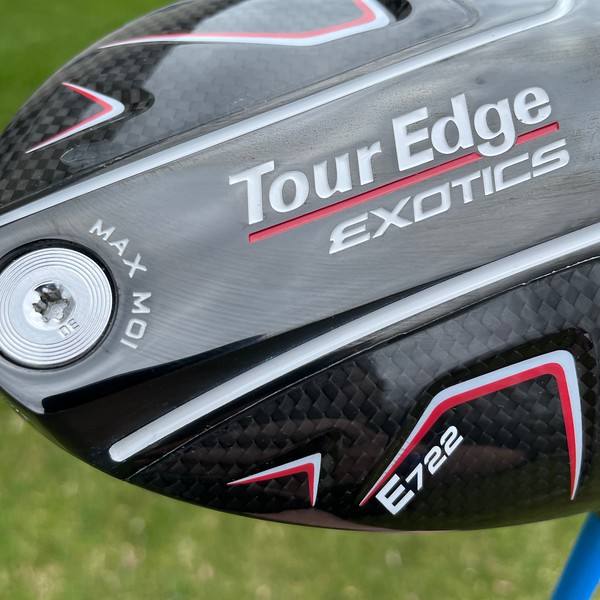Last year’s C721 driver created some serious buzz, which isn’t always the case for Tour Edge drivers, but it was warranted. Following up on a successful launch isn’t always the easiest thing to do, but with the release of the 722 drivers, Tour Edge believes they have taken what they learned from the past and made a driver lineup that will stand out on its merit. With all the excitement surrounding the brand, let’s look at what the new E722 driver offers.

Tour Edge took some cues from their Hot Launch lineup when they split their 722 lineup into different variants. Having a C (competitive) and E (extreme) classification isn’t wholly new to the Exotics line, although we only saw it in the 721 iron range in 2021. This time around, it includes everything, with the utility iron being the only exception.
After C721’s success, what created a need for expanding the E series within the Exotics brand? During a THP Live with Tour Edge, Jon Claffey, Vice President of Marketing, and Matt Neeley, Vice President of Product Development, laid out the direct reason. Adding the E series, specifically for the drivers, helped expand their fitting umbrella. Last season’s C721 driver performed incredibly well for golfers who had a high swing speed, and while the MOI was high, it still catered more to that higher ball speed player. With the introduction of the E722, golfers will get more MOI and more spin, which should help golfers who have a little less speed. All while still enjoying a premium design.

Tour Edge threw a lot of their top-notch tech into the E722. Not only does Ridgeback return, but it is also improved by becoming 20% thinner without sacrificing any of its structural integrity. This titanium spine wraps around the back of the head and acts as a brace to help support faster ball speeds across the entire face. As you may have guessed, with the reduction of material used for Ridgeback, we get 34% more carbon to help fill that void. By using more carbon, Tour Edge can redistribute weight within the head, a bulk of which resurfaces in the 30-gram back weight. The visual presence of a thinner Ridgeback, along with the expansion of the carbon fiber wrap, helps enhance the look of the crown. It won’t be everyone’s cup of tea, but in my opinion, it is superior to the C721 in this department.
Kudos to Tour Edge for what they have done with the overall shape of this driver. Whenever a company lists a driver at 460cc, it never tells the whole story. Some drivers are shallow-faced and incredibly deep, while others are the polar opposite. Yes, the E722 has a larger footprint than the C722, but it looks more like a modern player’s game-improvement driver than what we get with some of the max drivers out on the market.

During my testing rounds with the E722, it was hard not to be impressed by how forgiving and stable this clubhead was. Let’s give credit to that 30-gram weight to boost stability, as it helps push the MOI up to 5500 g/cm2, which is significant. I’ll be the first to admit that my swing is not up to full speed during this early part of the golf season, but that worked out well for this setup. When I say that I tested all over the face, I mean it. My most prevalent miss was low and out on the toe section. What impressed me the most was, even on toe strikes, just how well the ball would hold its line. When looking at my on-course stats with this in the bag, my fairways hit percentage was right around 60%.

When getting the E722 on a Foresight launch monitor, I wasn’t expecting to see crazy speed numbers, not because of the club but because of the status of my current game. Low and behold, the numbers do help illustrate what I expected to see. With a swing speed in the mid 90’s, I was getting ball speeds of around 139 MPH. After listening to Matt and Jon talk about the spin profile during their recent THP Live segment, I’m not surprised to see the numbers creep into the higher 2k range. They mentioned how, between the C722 and the E722, they could shift the spin around 1,000 RPMs from the forward-weighted C series and the back-weighted E series. After seeing these numbers, I’m confident that I could drop a little spin and still enjoy this head’s stability with the proper shaft, loft, and ball combination.

Tour Edge takes a slightly different route when choosing their shafts as they go with their Speed Tested philosophy. They put nearly every shaft on their Tour Edge Development Robot (T.E.D.) and search for the best performing shafts for each swing speed range. For the E722, golfers can choose the Fujikura Air Speeder, Ventus Red or Blue, and Mitsubishi TENSEI Orange, Blue, and White. Each shaft comes with an adjustable hosel that can alter the club’s loft by 2°.

Recently, THP Staff Writer James Miles published his review of the C722 driver, found here. Being in that competitive class, the C722 caters to that golfer demographic with characteristics such as a sub 460cc footprint and moveable weights. If you feel that driver is more in your wheelhouse, follow the link inserted above, and give that article a read. However, if you need more forgiveness and stability, the E722 could be the one that wins you over.
More information on the Tour Edge Exotics E722 driver can be found at www.touredge.com.
The Details
Available: Now
Price: $399.99
Lofts: 9.5°, 10.5°, 12°
Adjustability: +/- 2 Degrees
Shafts: Fujikura AIR Speeder, Fujikura Ventus (Red/Blue), Mitsubishi Tensei AV RAW (Blue, Orange, White)
The post Tour Edge Exotics E722 Driver Review appeared first on The Hackers Paradise.